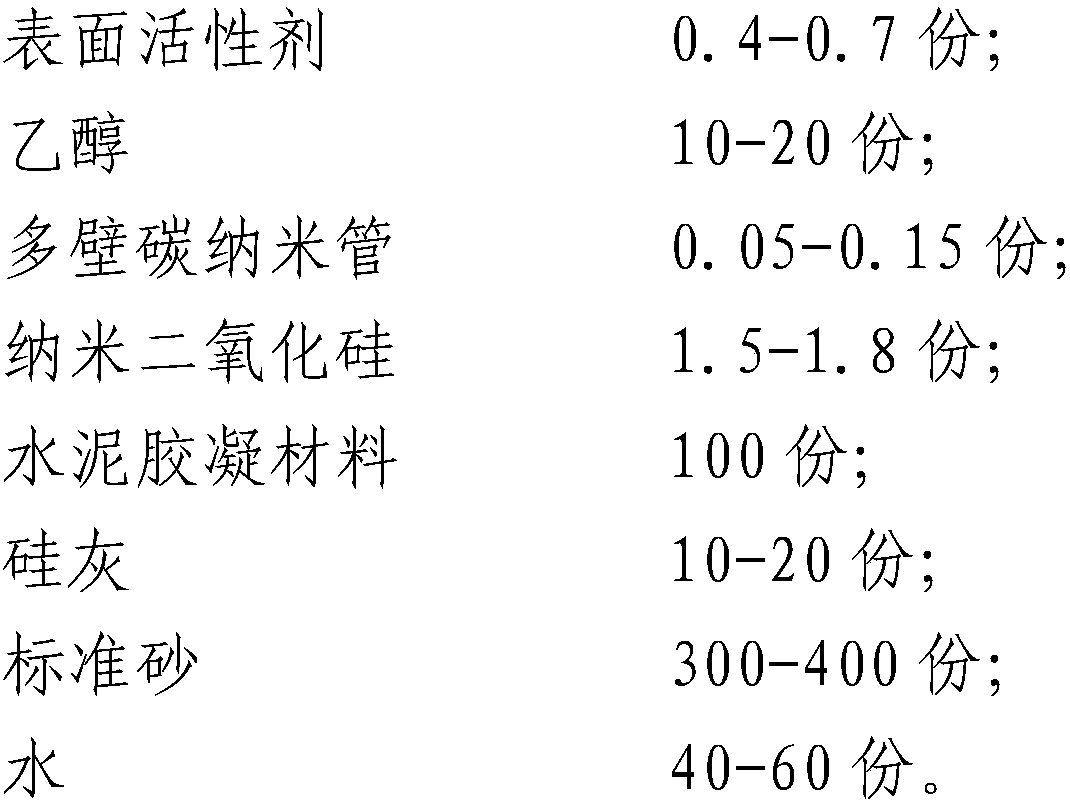Multiwall carbon nanotube cement-based composite material and preparation method thereof
A technology of multi-wall carbon nanotubes and composite materials, which is applied in the field of multi-wall carbon nanotube cement-based composite materials and its preparation, can solve problems such as multi-wall carbon nanotube agglomeration, and achieves simple and easy operation, small average pore size, cost controllable effect
- Summary
- Abstract
- Description
- Claims
- Application Information
AI Technical Summary
Problems solved by technology
Method used
Image
Examples
preparation example Construction
[0030] The preparation method specifically comprises the following steps:
[0031] Step 1, add the surfactant into ethanol and stir until completely dissolved; wherein, the surfactant is alkylphenol polyoxyethyl ether, sodium lauryl sulfate, sodium dodecylbenzenesulfonate, dodecyl One or more of sodium sulfonate, polyvinylpyrrolidone, and gum arabic.
[0032] Step 2, add multi-walled carbon nanotubes, nano-silica and glass beads, and perform mechanical stirring, grinding and dispersion for 1-1.5 hours;
[0033] Step 3, after filtering, place in an ultrasonic dispersion device for 0.5-1 hour ultrasonic dispersion to obtain a multi-walled carbon nanotube dispersion;
[0034] Step 4, after stirring the cementitious material, silica fume, and standard sand with water, add the dispersion liquid obtained in step 3, and stir evenly;
[0035] Step 5, put the multi-walled carbon nanotube cement-based slurry uniformly stirred in step 4 into a drying oven to keep at 50°C-60°C, and dry ...
Embodiment 1-5
[0041] Embodiment 1-5 concrete performance test sees the following table:
[0042] Table 2 Examples 1-5 Composite mechanical properties
[0043]
[0044] The following conclusions can be drawn from the results in Table 2:
[0045] (1) It can be seen from the control group that the compressive strength of the concrete test block prepared without adding carbon nanotubes is about 48MPa. Examples 1-3 all add a certain amount of multi-walled carbon nanotubes and after ultrasonic treatment, the mechanical properties of the cement-based composite material are significantly improved, and the compressive strength is increased by 11.6%-20.99%.
[0046] (2) In Example 3 and Example 4, although the addition ratio of carbon nanotubes is the same as 0.3%, the mechanical properties of the cement-based composite material in Example 4 do not increase but decrease, because the addition of carbon nanotubes is too high , not well dispersed, agglomeration occurred in the cement-based material...
PUM
| Property | Measurement | Unit |
|---|---|---|
| Compressive strength | aaaaa | aaaaa |
Abstract
Description
Claims
Application Information
 Login to View More
Login to View More - R&D
- Intellectual Property
- Life Sciences
- Materials
- Tech Scout
- Unparalleled Data Quality
- Higher Quality Content
- 60% Fewer Hallucinations
Browse by: Latest US Patents, China's latest patents, Technical Efficacy Thesaurus, Application Domain, Technology Topic, Popular Technical Reports.
© 2025 PatSnap. All rights reserved.Legal|Privacy policy|Modern Slavery Act Transparency Statement|Sitemap|About US| Contact US: help@patsnap.com



